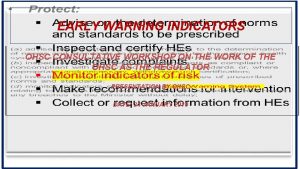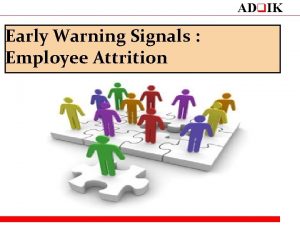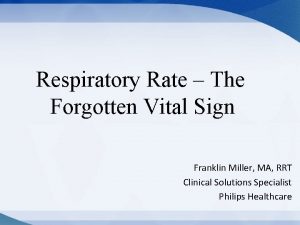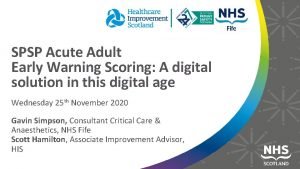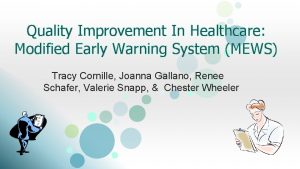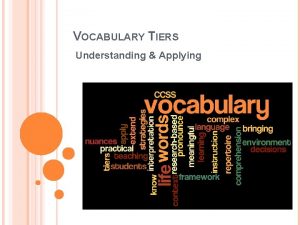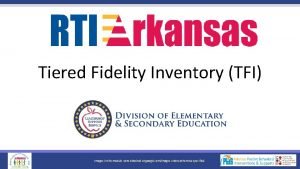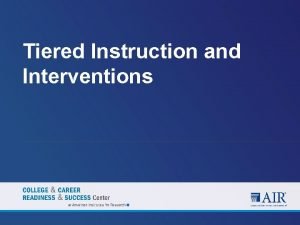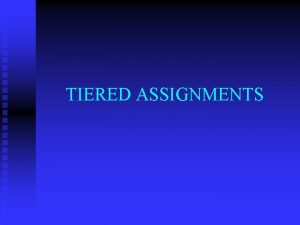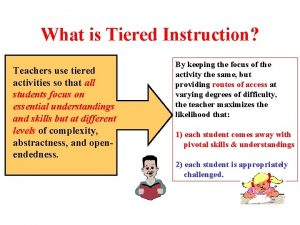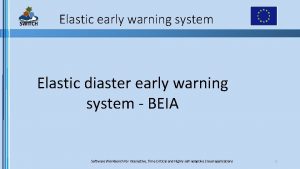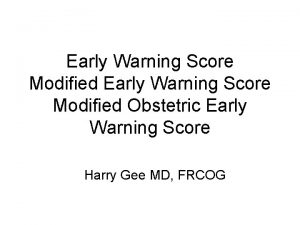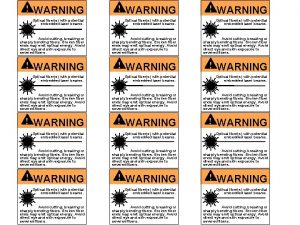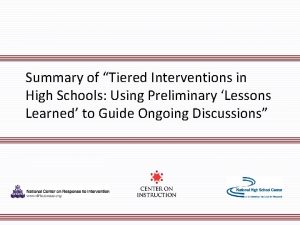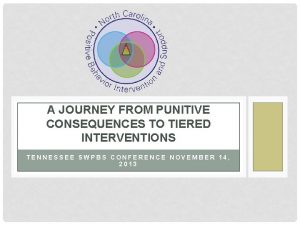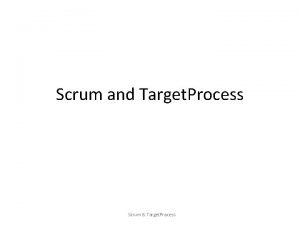Using Early Warning Systems to Target Tiered Interventions






























- Slides: 30

Using Early Warning Systems to Target Tiered Interventions for Dropout Prevention Mindee O’Cummings National High School Center © 2010 American Institutes for Research® www. betterhighschools. org

Sobering Statistics… • Nearly one-third of all high school students leave the public school system before graduating • 1. 2 million students drop out of high school each year – that’s 12 million over the next decade • 7, 000 students drop out of high school every day • 15% of the high schools in the U. S. produce 50% of our dropouts – schools Balfanz and Legters call “dropout factories” Balfanz, R. and Legters, N. (2006, July 12). The graduation rate crisis we know and what can be done about it. Retrieved online from http: //web. jhu. edu/CSOS/graduationgap/edweek/Crisis_Commentary. pdf © 2010 American Institutes for Research® www. betterhighschools. org

Economic Consequences • A new high school dropout in 2000 had less than a 50% chance of getting a job • That job earned less than half of what the same job earned 20 years ago • Lack of education is strongly correlated with welfare dependency and incarceration • Cutting the number of dropouts in half would reap $45 billion in revenues and decreased costs (Levin et al. , 2007) © 2010 American Institutes for Research® www. betterhighschools. org

Early Warning Systems Early warning systems (EWS) use readily available data housed at the school to: – Predict which students are at-risk for dropping out of high school – Target resources at the school and district level to support off-track students while they are still in school, before they drop out – Examine patterns and identify school climate issues that may contribute to disproportionate dropout rates at a subset of high schools or within subpopulations of students © 2010 American Institutes for Research® www. betterhighschools. org

9 th Grade is a Critical Year • Ninth grade is a “make or break year” – More students fail 9 th grade than any other grade in high school – A disproportionate number of students who are held back in 9 th grade subsequently drop out • By the end of 9 th grade or even during the first semester, powerful indicators exist that can predict whether students will complete high school: – Engagement – Course performance – Chicago’s “On-Track” Indicator Herlihy, C. (2007). State and district-level supports for successful transition into high school. Washington, DC: National High School Center. Allensworth, E. , & Easton, J. Q. (2007). What matters for staying on-track and graduating in Chicago Public High Schools: A close look at course grades, failures and attendance in the freshman year. Chicago: Consortium on Chicago School Research. © 2010 American Institutes for Research® www. betterhighschools. org

Key 9 th Grade Indicators © 2010 Engagement Course Performance • Attendance/ absenteeism • Course grades Research from several U. S. school districts provides a strong foundation for defining 9 th grade warning signs that students might drop out, but local adaptation is key “On-track” Indicator American Institutes for Research® • Number of credits earned • Core course performance & accumulated credits www. betterhighschools. org

“High-Yield” Academic Indicators: Attendance Four-Year Graduation Rates for CPS Students Entering High School in 2001, by 9 th Grade Absences (Allensworth & Easton, 2007) Percent Graduated in Four Years 100% 87% 80% 63% 60% 41% 40% 21% 20% 9% 5% 2% 1% 0% 30 -34 35 -39 40+ 0% 0 -4 5 -9 10 -14 15 -19 20 -24 25 -29 Days Absent Per Semester (Course Cutting Counted as Partial Days) © 2010 American Institutes for Research® www. betterhighschools. org

“High-Yield” Academic Indicators: Course Failures Four-Year Graduation Rates for CPS Students Entering High School in 2001, by Freshman Course Failures (Allensworth & Easton, 2007) Percent Graduated in Four Years 100% 85% 80% 70% 55% 60% 42% 40% 33% 25% 20% 13% 11% 7% 2% 0% 0 1 2 3 4 5 6 7 8 More than 8 Semester Course Failures © 2010 American Institutes for Research® www. betterhighschools. org

“High-Yield” Academic Indicators: GPA Four-Year Graduation Rates for CPS Students Entering High School in 2001, by Freshman GPA (Allensworth & Easton, 2007) Percent Graduated in Four Years 100% 93% 97% 86% 80% 72% 60% 53% 40% 28% 20% 6% 1% 0% 0. 0 0. 5 1. 0 1. 5 2. 0 2. 5 3. 0 3. 5+ Freshman GPA © 2010 American Institutes for Research® www. betterhighschools. org

Chicago’s “On-track” Indicator Students are “on-track” if they: 1. have not failed more than one semester long core course, AND 2. have accumulated enough credits for promotion to the 10 th grade. Number of Semesters with Fs in Core Courses © 2010 # of Credits Accumulated Freshman Year Less than 5 5 or more 2 or more courses Off-track 0 or 1 courses Off-track On-track American Institutes for Research® www. betterhighschools. org

On-Track Indicator Source: Allensworth & Easton (2005) © 2010 American Institutes for Research® www. betterhighschools. org

“High Yield” 9 th Grade Indicators © 2010 Indicators Benchmark (red flag) Absenteeism Missing 10% or more of instructional time Course failures One of more failed courses Grade point average 2. 0 or lower (on a 4 -point scale) “Off-track” Fail two or more semester core courses, or accumulate fewer credits than the number required for promotion to the 10 th grade American Institutes for Research® www. betterhighschools. org

Implementing the EWS Process STEP 1 – Establish Roles and Process STEP 6 - Reflect and Revise STEP 2 – Use the EWS Tool STEP 3 – Analyze EWS Data STEP 5 – Apply Interventions STEP 4 – Interpret EWS Data © 2010 American Institutes for Research® www. betterhighschools. org

Step One: Establish Roles and Process EWS teams should include school- and district-level individuals who have: – Authority to make decisions – Knowledge of diverse students – Expertise to manage and analyze data – Information about strategies © 2010 American Institutes for Research® www. betterhighschools. org

Step Two: Use the EWS Tool • Routinely available data are good predictors of whether a student is likely to drop out of high school • First-month absences, in addition to end of the semester grades, are additional strong predictors of dropout • The goal is to effectively and efficiently allocate dropout prevention resources to change the odds for students with a high propensity to drop out – Not all students at-risk will need all interventions available – Analysis of different patterns of risk can help target appropriately – EWS data = knowledge to make these decisions © 2010 American Institutes for Research® www. betterhighschools. org

© 2010 American Institutes for Research®

© 2010 American Institutes for Research®

© 2010 American Institutes for Research®

© 2010 American Institutes for Research®

© 2010 American Institutes for Research®

© 2010 American Institutes for Research®

Step Three: Analyze EWS Data Questions about EWS data: • Student-level patterns: What do your data tell you about individual students who are at-risk? • School-level patterns: What do your data tell you about how the school is doing? – Are students who were flagged from the beginning remaining “off-track” through the year? – Are students who were flagged at one reporting period back “on-track” at the next? © 2010 American Institutes for Research® www. betterhighschools. org

Step Four: Interpret EWS Data Digging deeper than the indicators: • Indicators are just observable signals, not root causes • Characteristics of students who are flagged can further help target interventions at the appropriate intensity © 2010 American Institutes for Research® www. betterhighschools. org

Step Four: Interpret EWS Data (cont. ) Understanding Characteristics of Students At-Risk • Decisions to persist or drop out are affected by multiple contextual factors - family, school, neighborhood, peers. • Personal and school factors contribute to success or failure during the freshman year • Attendance and course performance problems are distinct indicators in the EWS but are highly interrelated, and both can signal disengagement • Student background characteristics are less important in explaining failures than behaviors in high school © 2010 American Institutes for Research® www. betterhighschools. org

Step Five: Applying Interventions • • • • © 2010 Focus on achievement in core courses Content recovery courses Tutoring as an academic support Tiered approaches Attendance and behavior monitors Advisories and team teaching Counseling and mentoring Small learning communities and school within a school for greater personalization Partnerships between high schools and feeder middle schools Ninth grade transition programs Support for students with disabilities outside of school Career and college awareness Family engagement Community engagement American Institutes for Research® Example Programs that incorporate this strategy: America’s Academic Middle Project Check Career ALAS and College Academies GRAD Choice Literacy Connect High Program School America’s Talent Positive NGP Check Ninth PBIS Learning First Things Grade Development and Behavioral to. Choice Connect Work First Success Program High School Interventions Academies (NYC) and School Coca-Cola STEP First Middle Support Career Things College Development Academies Center VYP First High for School Supports (PBIS) STEP Lifelong Program Adolescent Options Mothers Program Interpersonal NGP Check and Connect Relations Rehabilitation, (LOP) (Family Growth Center) Talent Personal Development Growth Class High Project Support COFFEE Center for. National Empowerment, Middle NGP School College High School NGP PBIS Project Adolescent COFFEE Mothers supports, Education, and Talent Development High Project Talent (Family Development COFFEE Growth Center) High Work (RENEW) Quantum Project Twelve School COFFEE Together Opportunities School RENEW Middle Program College High School RTI Talent Development School Twelve NGP School Development Together Strategic Instruction Model Program Teen Quantum Outreach Opportunities Program Talent Program Development High School Teen Outreach Program Twelve Together

Tiered Approach to Dropout Prevention Tier Three Individualized Tier Two Targeted Tier One Universal © 2010 American Institutes for Research® www. betterhighschools. org

New Hampshire's Model Individualized Targeted School-wide © 2010 American Institutes for Research® Examples: RENEW (Rehabilitation, Empowerment, Natural supports, Education and Work) facilitators Examples: Intervention Team of specialists and administrators will focus on students who exhibit challenging behaviors and who are at risk Examples: Positive Behavioral Supports model (PBS) and Universal Leadership Team including a diverse representation of “opinion-leaders” www. betterhighschools. org

Minnesota’s Model Targeted Selected Universal © 2010 American Institutes for Research® Examples: Individualized behavior plans, wrap-around services, alternative programs (5% of students) Examples: Interventions build specific skills, school-within-a-school model, or mentoring programs (15% of students) Examples: Extracurricular activities, school-to-work programs, or positive discipline programs www. betterhighschools. org

Step Six: Reflect and Revise • During the school year: Regularly, collectively, and systematically • Over multiple school years: Validate the indicators to maximize predictive power of the system, e. g. Displayed Early Warning Sign in 9 th Grade? Graduated in 4 (or 5) Years? YES NO © 2010 American Institutes for Research® YES False Positive (or Effective Intervention) Accurate Prediction NO Accurate Prediction False Negative www. betterhighschools. org

More Information: Dropout Prevention Resources www. betterhighschools. org/topics/ Dropout. Prevention. asp Contact Information Mindee O’Cummings– mocummings@air. org © 2010 American Institutes for Research® www. betterhighschools. org
 Earthquake early warning systems
Earthquake early warning systems Earthquake early warning systems
Earthquake early warning systems Nimble page management for tiered memory systems
Nimble page management for tiered memory systems Icews
Icews Early warning intervention and monitoring system
Early warning intervention and monitoring system Early warning system in disaster management
Early warning system in disaster management Ohsc early warning system
Ohsc early warning system Ohsc early warning system
Ohsc early warning system Pews
Pews Early warning attrition tracker model
Early warning attrition tracker model Balistic missle
Balistic missle Maternity early warning score chart
Maternity early warning score chart Early warning score
Early warning score Early warning score
Early warning score örontemperatur
örontemperatur How much does arimidex increase survival
How much does arimidex increase survival Sri lanka tsunami warning system
Sri lanka tsunami warning system Nec activity schedule example
Nec activity schedule example Fife early warning score
Fife early warning score Mews early warning system
Mews early warning system Primary target market and secondary target market
Primary target market and secondary target market Module 10 topic 1 vehicle warning systems
Module 10 topic 1 vehicle warning systems Flood storage areas advantages and disadvantages
Flood storage areas advantages and disadvantages Early cpr and early defibrillation can: *
Early cpr and early defibrillation can: * Vocabulary pyramid
Vocabulary pyramid Tier 1 2 3 vocabulary words
Tier 1 2 3 vocabulary words What is tiered assignments
What is tiered assignments Dynamics 365 tiered pricing
Dynamics 365 tiered pricing Tiered assignments examples
Tiered assignments examples Tiered fidelity inventory pbis
Tiered fidelity inventory pbis Two tiered board structure
Two tiered board structure






